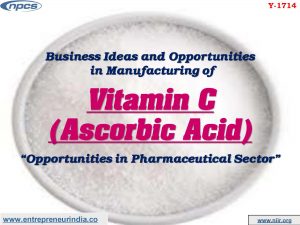
Introduction
Vitamin C (ascorbic acid) is the most abundant natural hydro-soluble antioxidant used as a dietary supplement for humans. It can be contained in a number of fruits and vegetables, including lemons, oranges, and broccoli. It is also a critical cofactor for a number of metalloenzymes in the human body. Furthermore, because of its antioxidant properties, ascorbic acid is needed by the agriculture, food, beverage, and pharmaceutical industries. The pharmaceutical industry is the largest user of ascorbic acid, accounting for one-third of total production.
Related Project:- Investment Business Idea in Vitamin C Manufacturing Plant
Uses of vitamin C
Because of its antioxidative properties, industrially generated L-ascorbic acid is commonly used as a dietary supplement and preservative in the feed, food, and pharmaceutical industries. Vitamin C is an essential nutrient for the human body. It is needed to keep the skin, cartilage, teeth, bone, and blood vessels healthy. It’s also used to keep your body’s cells protected from injury. It’s referred to as an ant. It is now commonly promoted as a natural cure to the common cold. Despite its popularity as an “immune booster,” there is no evidence that taking vitamin C will actually prevent or treat infection.
Related Books:- Pharmaceutical, Drugs, Proteins Technology Handbooks
Production process of vitamin C
Additional bio-oxidation steps with Ketogulonicigenium vulgare as a biocatalyst are used in the production process to transform d-sorbitol to the intermediate 2KGA without the use of chemicals. The enzymes involved have a wide substrate variety but exhibit remarkable regiospecificity. The preferences of these enzymes for some of the many isomeric structures that carbohydrate substrates follow in aqueous solution explain this perplexing specificity pattern. Novel enzymes have recently been discovered that produce l-ascorbic acid directly from L-sorbosone, an intermediate in the bio-oxidation of d-sorbitol to 2KGA. This removes the need for 2KGA chemical rearrangement and allows for a direct route from d-sorbitol to l-ascorbic acid. The development of d-isoascorbic acid, the C5 epimer of l-ascorbic acid, follows similar industrial principles. D-isoascorbic acid has the same C5 conformation as d-glucose and can be made more easily from this common carb than l-ascorbic acid.
Related Videos:- Pharmaceutical, Drugs, Fine Chemicals, Bulk Drug Intermediates, Pharmaceutical Drugs, Pharma Drug Ingredients Intermediates, Pharmaceutical Bulk Drugs
Market Outlook
The strong application spectrum in the cosmetics, pharmaceutical, animal feed, and processed food industries is driving the market size of vitamin C. It’s primarily found in fruits and vegetables, and it’s also taken as a dietary supplement. It’s used to avoid heart failure, vision disorders, immune system defects, skin wrinkling, and prenatal health problems. By 2024, the global vitamin market could be worth more than USD 10 billion. Vitamin C is a natural antioxidant that protects cells from free radical damage when they are exposed to radiation or UV rays. It is involved in protein metabolism and is needed for collagen biosynthesis. During the period 2020-2025, the ascorbic acid market is expected to develop at a CAGR of 5.1 percent.
Books: – BOOKS & DATABASES
Indian Govt Initiative for Vitamin C Production
In the wake of domestic producers arguing for the implementation of a levy, India has launched an anti-dumping inquiry into vitamin C imports from China.
Read our Book Here: Handbook on Active Pharmaceutical Ingredients (API), Drugs & Pharmaceutical Products
The move comes days after the Directorate General of Trade Remedies (DGTR) of the Commerce Ministry placed a six-month provisional anti-dumping duty on anti-bacterial medication Ciprofloxacin Hydrochloride imports from China. The investigation has been launched after Bajaj Healthcare said that ‘dumped imports’ of vitamin C from China are harming the domestic industry.
Market Research; – Market Research Report
“In terms of important product characteristics such as physical and chemical characteristics, manufacturing process and technology, functions and uses, product requirements, pricing, and distribution, subject products manufactured by domestic industry and PUC (product under consideration) imported from subject country (China) are comparable. The products’ marketing and tariff classification,” the company had said.
Key Players:-
- Dishman Pharmaceuticals & Chemicals Ltd.
- Glaxosmithkline Pharmaceuticals Ltd.
- Gulshan Polyols Ltd.
- Kasyap Sweetners Ltd.
- M S Healthcare Pvt. Ltd.
- Pfizer Healthcare India Pvt. Ltd.
- Pfizer Ltd.
For More Details:- https://www.entrepreneurindia.co/project-and-profile-details/Production%20of%20Vitamin%20C%20(Ascorbic%20Acid)
